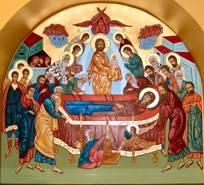Dormition
DORMITION OF THE THEOTOKOS

Objectives:
- Students should understand the icon, who’s in it and what it means.
- Students should know that we celebrate the Dormition on August 15, and that it is preceded by 2 weeks fast from meat.
- Students should know why we celebrate it with flowers.
Possible Lesson Plan:
- Open with prayer.
- Look at the icon together and see how much the students already know: The Theotokos is on her funeral bier; Christ is standing behind her, ready to receive her soul (small child in His arm) into heaven. The apostles stand on either side of the bier; who’s on the front left? (Peter at the head of the bier) and who’s on the front right? (Paul at the foot of the bier) Who’s that man below the bier? He is Antoninus the Jew! What shape do Mary and Jesus make? (a cross!)
- Review the story itself:
After Pentecost, Mary stayed in Jerusalem, comforting the young Christian Church there. In her early fifties, she was near death. The apostles were scattered all over the world preaching the gospel. However, they all were miraculously returned to Jerusalem in time for her burial – all except Thomas. Remember Doubting Thomas? As Mary fell asleep, Jesus appeared with His angels to carry her soul to heaven. Thomas arrived late, and when the others took him to her tomb in the Garden of Gethsemane, the tomb was empty. Mary had been taken to heaven!
Antoninus the Jew is depicted on the icon. He was a fanatical Jew, who tried to overturn the coffin of Mary to dishonor her body. An archangel was sent and cut off his hands to stop him from this disgraceful act. Later in his life, Antoninus became a Christian and was healed.
- Scripture readings:
Gospel: Luke 10:38-end, 11: 27-28
Epistle: Philippians 2:5-11
Old Testament: Genesis 28:11-17, Ezekiel 43: 27-44:14, Proverbs 9:1-11
- Songs of the Feast:
Troparion: When thou didst give birth, O Theotokos, thou didst preserve thy virginity; and in thy falling-asleep thou has not forsaken the world; for thou wast translated to Life since thou art the Mother of Life. Wherefore, by thine intercessions, deliver our souls from death.
Kontakion: Truly, the Theotokos, who is ever watchful in intercessions, who is never rejected, neither tomb nor death could control. But being the Mother of Life, He Who dwelt in her ever-virgin womb did translate her to life.
- Discussion questions;
Is the feast of the Dormition chronicled in Scripture? Does this mean that this is only legend? What is the purpose and importance of Holy Tradition? Is the Dormition the same as the Immaculate Conception, as taught by the Roman Catholic Church? If Mary were not bodily raised, how come we have no relics of her body?
What is the meaning in the Troparion of “you did not forsake the world”? What is Mary doing now in heaven? (interceding for us) Has Mary ever appeared on earth since her Dormition? One instance is celebrated in the feast of the Protection of the Virgin on October 1, when Mary appeared in Constantinople, on the steps of a church praying and crying, and the imminent barbarian invasion miraculously disappeared. What are miraculous icons? (icons that weep or exude a fragrant odor or produce healing oil) They are almost always icons of the Virgin Mary, showing her continuing love as a mother for all of us.
The Megalynarion, or hymn to Mary, sung most Sundays during Divine Liturgy, beginning “It is truly meet…” also had miraculous origin, when the angel Gabriel, disguised as a monk, inscribed the words on a stone tablet with his finger during the prayers of a monk on Mount Athos, pictured on this icon.
Why do we celebrate this feast with flowers? When the apostles went to the tomb and found it empty, the tomb was filled with the overwhelming fragrance of flowers. Flowers are brought to church and blessed; they can then be taken home to fill the home with their fragrance.
- Make a felt banner or icon as before -- see Overview. Here are a few ideas:
8. Close with prayer.